Speech Inflation and Changing Public Attitudes

Ian Macfarlane
Deputy Governor
Talk to the Australian Society of Corporate Treasurers, the Securities Institute of Australia
and the Financial Executives Institute
Adelaide –
PDF version 82KB
It is a pleasure to be in Adelaide and to have the opportunity to address such an interesting group. Corporate treasurers, security analysts and financial executives all have an interest in the economy, and particularly in its financial aspects. You have all probably thought a lot about business strategies and how they have to adapt to a changing environment. Today, I would like to talk about economic influences on these strategies and on people's attitudes and expectations in general. Specifically, I would like to look at how large changes in the macroeconomic environment affect the way people go about running their businesses and their households.
Looking around this audience, I would judge the average age to be 40 to 50. This means that most people's careers would have extended over the last 20 or 30 years, and thus been dominated by the events of the 1970s and 1980s. What was unique about this period? What were the major macroeconomic events that shaped people's attitudes, and made it such a different era from the one experienced by their parents and grandparents?
The answer to this is not obvious because there were so many changes occurring in the 1970s and 1980s. The business cycle became more pronounced with recessions in 1974, 1982 and 1990; unemployment rose to much higher levels; the current account deficit widened and external debt rose; and inflation became a regular feature of the economic landscape. It was a very difficult era in which to be making business decisions. As quickly as one problem was solved, another presented itself. There was always the uncertainty as to whether a change was permanent, and thus requiring adjustment, or whether it would go away.
Some History
If we take a long sweep of history, most of the changes that occurred can be seen as old problems reasserting themselves, rather than new problems. There are very few things in economics that are totally new. For example, the levels of unemployment reached in recent decades are disturbing, but they were a good deal higher in our grandparents' working lives during the 1930s (Graph 1). The current account deficit reached 6 per cent of GDP on several occasions in the last two decades, but it had been as high as 15 per cent of GDP in earlier periods, and the ratio of external liabilities to GDP, which is now about 60 per cent, is estimated to have averaged 130 per cent in the 1930s (Graphs 2 and 3). The point of these historical comparisons is to show that we had always lived with economic uncertainty – the risk of an economic contraction, widespread business failures and sharp changes in our external trading conditions.
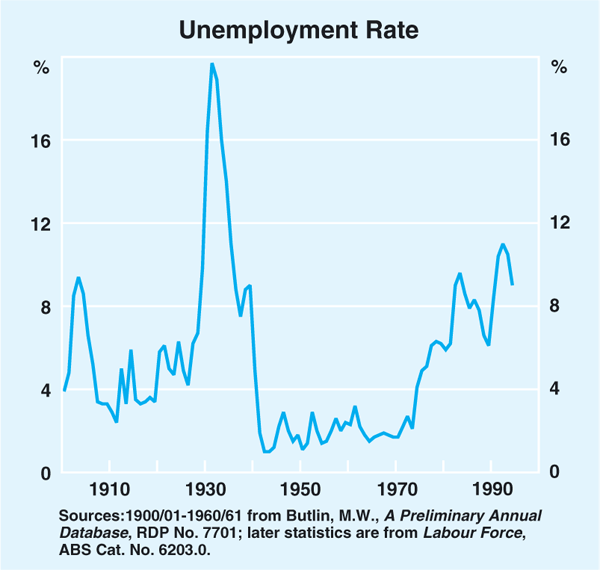
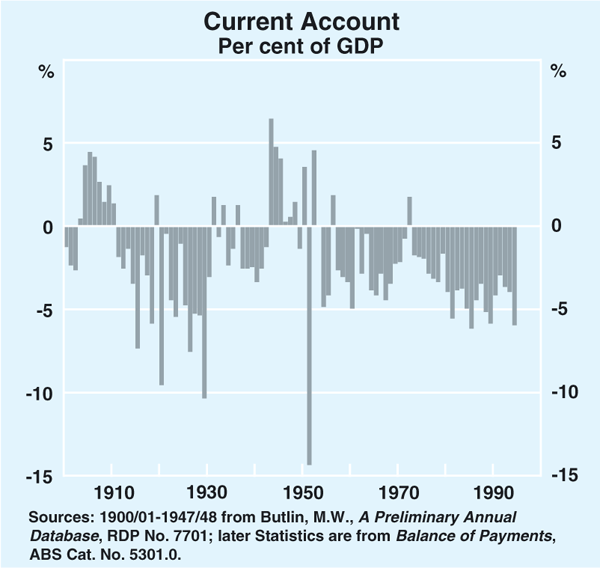
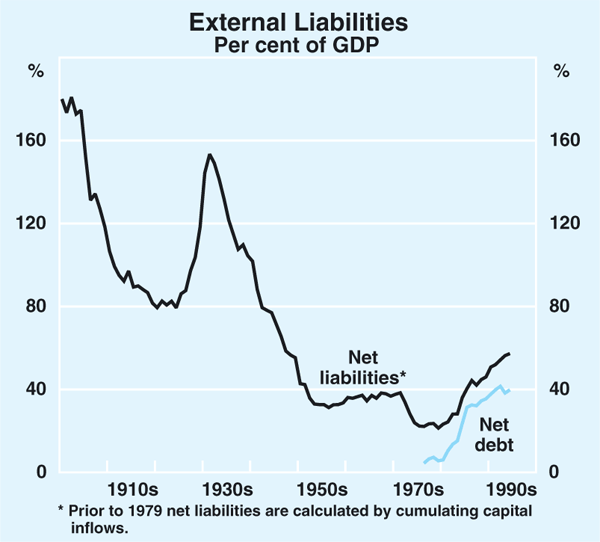
It is only when we come to inflation that we find something which is truly unprecedented. Economic historians have been able to construct measures of the price level for countries going back many centuries. I have reproduced one here for the United Kingdom going back to 1600 (Graph 4). The thing that stands out is that, except for the period around 1800 when the Napoleonic wars were taking place, the first 350 years were characterised by an approximately stable price level; that is, the average rate of inflation was zero. In Australia's case, we can only go back to about 1850, but a similar picture emerges (Graph 5). The price level in the 1940s was about the same as it had been in the 1850s. In individual years, there were some significant positive rates of inflation, but in other years there were negative ones. Over the first 90 years shown in the graph, the average rate of inflation was approximately zero.
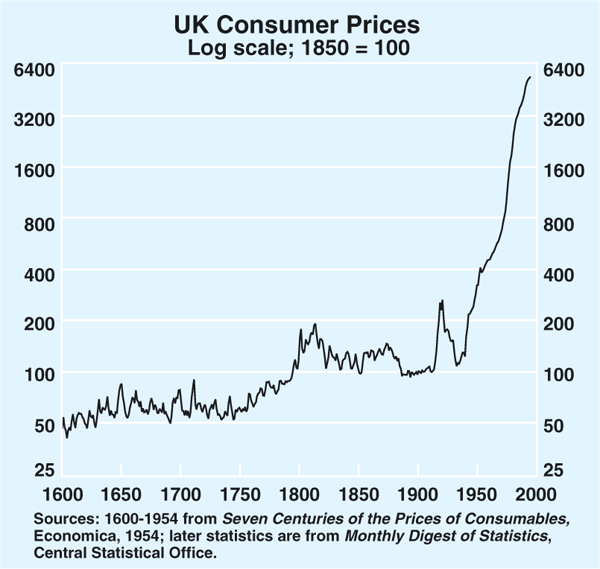
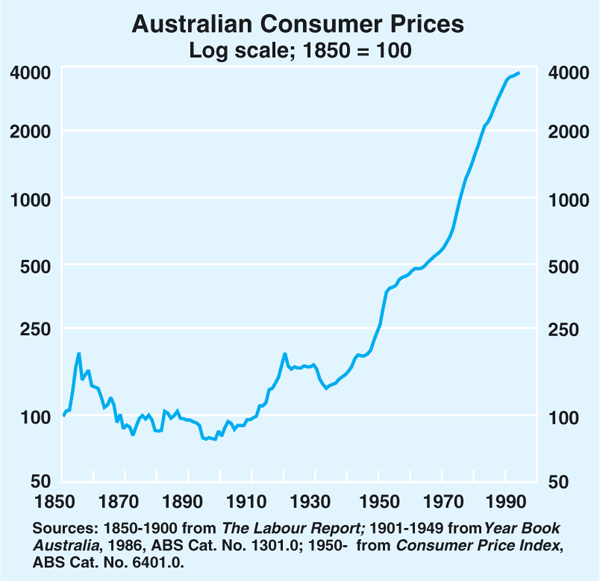
When we come to the post-World War II period, the picture changes. For the first time, we enter an era where inflation is positive in virtually every year.[1] This is true not just for Australia but for all countries.
Some changes in attitudes started to emerge in the first two decades after the Second World War, but the changes were not large. Although inflation was positive year in and year out, it was generally rather low and did not have a significant impact on business decisions.[2] In the 1970s, that all started to change. Inflation in most countries reached double digits, and averaged somewhere near that for a decade or more. It was in this period that attitudes started to change very sharply, and an inflationary mentality emerged in a number of ways.
Businesses and households became more prepared to take risks in the sense of over-extending their budgets to buy assets. They did this because moderate to high inflation meant that asset prices nearly always rose. They were less inclined to be frugal, to save and to invest in such old-fashioned channels as bank deposits, bonds and other interest-bearing assets. There seemed to be more risks in delaying the purchase of an asset, such as a house, than in buying it before it could be comfortably afforded. Businesses and households came to rely more on debt, and high gearing was regarded as a sign of being financially astute rather than reckless. Lenders were reluctant to commit for anything other than short periods so financial contracts shortened, as did wage contracts.
Ultimately, high inflation had to be brought down, and we saw this happen in country after country over the past decade. For some, such as the United States and Germany, it happened in the mid 1980s; for others, such as Australia and New Zealand, it occurred in about 1990. The process was not a pleasant one, and in each country it involved periods of extremely high interest rates and ultimately an economic recession. It would have been better if someone had found a way to bring inflation down without those accompaniments, but no-one has.
The Present Low Inflation World
We are now back in a world where low inflation is the norm. The average inflation rate among OECD countries is lower than for most of the 1960s, and there is very little dispersion around this average. We are effectively in a world of 2 to 3 per cent inflation and there is every prospect of it oscillating around this average level for the foreseeable future. Australia has shared in this experience, and over the most recent five years – that is, in the five years to the September quarter 1995 – underlying inflation has averaged 2.7 per cent (headline inflation is a shade lower).
Partly because of a desire to ‘lock in’ our own low inflation rate, and partly in recognition of this fundamental change in the world economy, the Reserve Bank of Australia moved a couple of years ago to introduce an ‘inflation target’. Under this, we aim to achieve an average underlying inflation rate of somewhere between 2 and 3 per cent over the medium term. This does not mean we will always be within the 2 to 3 per cent range, but that when we look back after a number of years we should see an average inflation rate of 2-point-something. This is not an overly ambitious target by current world standards; about two-thirds of OECD countries are presently achieving it (Table 1). It represents a broad measure of world best practice and, as in so many other economic areas, there is no reason why Australia should settle for any less than the world standard.
| 5-year annual average to Sep. quarter: | Year-to-Sep. quarter 1995 |
||||
|---|---|---|---|---|---|
| 1980 | 1985 | 1990 | 1995 | ||
| Australia | 9.1 | 8.2 | 7.3 | 2.7 | 3.1 |
| Austria | 5.3 | 4.7 | 2.4 | 3.2 | 2.3 |
| Belgium | 6.3 | 7.0 | 2.1 | 2.5 | 1.3 |
| Canada | 8.7 | 7.2 | 4.4 | 2.2 | 2.4 |
| Denmark | 10.4 | 7.6 | 4.0 | 1.9 | 1.7 |
| Finland | 10.6 | 8.4 | 5.0 | 2.2 | 0.5 |
| France | 10.6 | 9.4 | 3.0 | 2.2 | 1.6 |
| Germany | 4.0 | 3.7 | 1.4 | 3.6 | 1.7 |
| Ireland | 14.5 | 11.9 | 3.2 | 2.5 | 2.4 |
| Italy | 17.1 | 13.7 | 5.6 | 5.1 | 5.8 |
| Japan | 6.7 | 2.6 | 1.3 | 1.3 | −0.2 |
| Luxembourg | 6.0 | 7.1 | 1.6 | 2.8 | 1.7 |
| Netherlands | 5.9 | 4.0 | 0.8 | 2.6 | 1.3 |
| New Zealand | 14.9 | 12.1 | 9.1 | 2.3 | 2.0 |
| Norway | 8.4 | 8.8 | 6.2 | 2.3 | 2.1 |
| Portugal | 22.0 | 23.1 | 11.5 | 7.0 | 3.9 |
| Spain | 18.5 | 11.9 | 6.5 | 5.0 | 4.3 |
| Sweden | 10.3 | 8.9 | 6.4 | 3.9 | 2.1 |
| Switzerland | 2.4 | 4.1 | 2.6 | 3.1 | 2.0 |
| United Kingdom | 13.7 | 6.8 | 5.3 | 3.7 | 2.9 |
| United States | 8.9 | 5.3 | 4.0 | 3.0 | 2.5 |
| Average | 7.6 | 5.0 | 3.2 | 2.7 | 2.0 |
| * OECD CPI data, except for Australia, New Zealand (after 1990) and the United Kingdom where underlying measures have been used. | |||||
Business and Household Attitudes
With five years of low inflation behind us, it is interesting to look around and see whether businesses and households have made any major adjustments away from the behaviour that they learnt in the 1970s and 1980s. I think if we look closely we will see that there have been some important changes, although they have not been as complete as some of us would wish.
- Businesses have made a major shift in their financing strategies in the direction of relying much less on debt and more on equity; gearing ratios have fallen appreciably. At the same time, they have become disinclined to build up their balance sheets by making acquisitions in industries outside their areas of expertise. An acquisition would not be ruled out – either domestically or offshore – but businesses look much more carefully at its price and its fit with their overall business than formerly.
- Businesses have also become much more cost conscious. They now see cost control and efficiency as more important ways of building a sustainable business, and place less emphasis on increasing scale through debt-financed acquisition or expansion.
- Households and businesses are adopting a longer time horizon in their financing decisions. The best example of this is the re-emergence of fixed-interest borrowing for housing mortgages, which now accounts for 16 per cent of new mortgages. Under these loans, interest is typically fixed for three years, in contrast to the standard variable-rate loan where the interest rate can change a number of times each year.
- In wage setting, there has been a return to multi-year wage bargaining with two-year agreements quite common and some of three years or more. There has also been a move away from explicit indexation in wage settlements, although cost of living considerations are not excluded entirely. It is not very long ago that Australian wage setting was characterised by extreme short-termism in the form of quarterly national wage cases based on indexation principles.
- There is evidence from surveys of price expectations, from the bond market and from the price forecasts of business economists that expectations of future inflation are about half what they were in the 1980s.
The above list is quite encouraging, particularly as these developments took place within the space of a few years. It took about 15 years for the earlier inflation-based attitudes to reach their full development, so we should not expect to be able to turn things around very quickly. There will still inevitably be some entrenched attitudes and expectations that will take longer to change.
One such attitude concerned the return that businesses were expecting on investment. When asked what hurdle rates of return they required, many businesses nominated the same high rates that they had required in the past, such as 15 per cent or more after tax return on equity. If this was the right rate when inflation was 8 or 9 per cent, it must clearly be too high in a world where inflation was 2 or 3 per cent. For a time it looked as though the higher hurdle rates implied by this attitude might be holding back investment in plant and equipment. The recent strength in this sector suggests that this difficulty has now been overcome.
Another such attitude concerns wage bargaining, where, after several years of low wage increases, there has been a pick-up over the past 12 months. Most enterprise bargains are now incorporating annualised increases of around 5 per cent. As a result, ordinary-time earnings are running at 5 per cent, with those in the private sector (including executive salaries) running at 6 per cent. Clearly, these will have to come down as they are inconsistent with the low-inflationary world we now live in. A stronger exchange rate, or some squeezing of profit margins, would help to cushion final product prices temporarily from higher labour costs, but on-going wage increases of 5 per cent or more would not be consistent with holding inflation to an average of between 2 and 3 per cent.
A third area where inflationary preferences are dying slowly is housing. A number of recent reports suggest that there is a lot of dissatisfaction with the present economic recovery because house prices are not rising. The implication is that many people regard rising house prices as a necessary pre-condition for them to feel an improvement in their economic well-being. These uneasy feelings have been fuelled by other reports suggesting that house prices are falling and that the British phenomenon of ‘negative equity’ is becoming apparent in Australia. I would like to make a few comments on these reports, starting with the facts, and then moving onto more general issues.
It is true that house prices generally have not risen much during the present recovery (Graph 6). It has been a low-inflation recovery and one consequence has been relatively stable house prices.[3] While house prices will no doubt keep up with, or exceed, inflation in the long run, there are bound to be periods when they do not. In a low-inflation environment, periods of stable house prices will probably be more common, but even in earlier years there were periods as flat as the present, e.g. between 1982 and 1986. When it comes to falling prices, however, there is not much evidence at the national or State level. It is only if you get down to the local area level that there are figures suggesting falls, and these are mainly in certain areas such as parts of southern Queensland and Canberra which had shown noticeable rises a few years earlier. It is possible in some individual cases that the fall was large enough to exceed the owners' equity, but they would be rare.
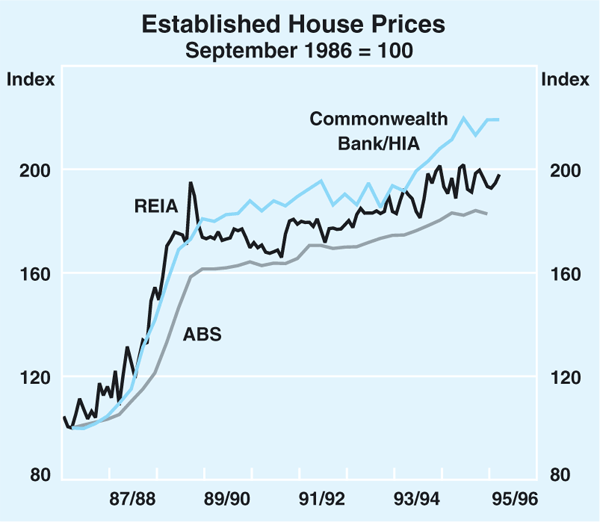
On the more general issue, why are people dissatisfied with stable house prices? Why do they prefer rising prices, or even rapidly rising prices? In large part, it is presumably because of the increase in their wealth as the equity in their homes rise. The increase is particularly marked in the cases where the asset is geared, i.e. where the owners still have a mortgage. This gives people an increased feeling of security. To some extent, this is understandable from the point of view of the individual home owner, particularly as it is usually accompanied by a general rise in inflation which results in the additional windfall of the real value of debt being reduced.
But it is a mistake to assume that this represents the whole of the story. For a start, the enhanced wealth is in a form which is unlikely to be realised – how many of us sell our house and live in something of lower quality in order to ‘cash in’ the higher wealth for use on some other form of expenditure? Moreover, even if it turns out that, in the future, the spread of ‘home equity’ type loans allows more household wealth to be realised, without actually selling the asset (which itself raises some serious questions of the allocation of savings), there is still a problem. While periods of quite strong increase in house prices make the present owners of housing richer, they also make those next in the queue poorer. The increase in wealth that house owners receive from higher prices is really a transfer from those newly entering the market, or aspiring to do so.
There are significant inter-generational implications here. Who are these new aspirants? They are the new households, those formerly renting, often with young children, and immigrants. In many instances, these are the children of the older, now-enriched, property-owning group. It is not too much of an exaggeration to suggest that a significant rise in the real price of housing, in effect, makes some people better off at the expense of their children.
That is not to suggest that house prices should never rise. In an environment in which inflation is low and stable, where people's financing decisions are not infected by the inflationary mentality, and interest rates are low, there will most likely be some gentle rise in house prices. However, in a stable environment such as this – and such as we presently find in Australia – the system is much more likely to work well, and inter-generational equity is likely to prevail.
It is just possible, of course, that through inheritances and so on, these inter-generational issues can be handled whatever the course of housing prices may be. But that seems an improbable solution, even with goodwill on the part of the older generation. More likely, whenever real house prices rise abruptly, there is likely to be, at least for a period of time, real hardship thrust upon the generation trying to achieve home ownership.
So I want to suggest that it is far from obvious that there should be great community dissatisfaction during periods of stability in house prices, as if rising prices were somehow a general ‘good’. It is all very well to dwell on stories of those who had arranged their affairs banking on a rise in prices and are now disappointed. A more thoughtful approach, on the other hand, might consider the expanded options available, as a result of stable conditions, to those who do not yet have a mortgage (and so are not as vocal as some others might be), but who would like to have one some day.
Endnotes
The only year in the last 50 years where inflation was negative in Australia was 1961. [1]
To quote Chairman Greenspan's words, it was low enough that it did not ‘materially enter business and household financial decisions’ and ‘inflation expectations were essentially negligible’. [2]
For a fuller account of recent developments, see ‘Trends in the Housing Sector’, Reserve Bank of Australia Bulletin, September 1995. [3]